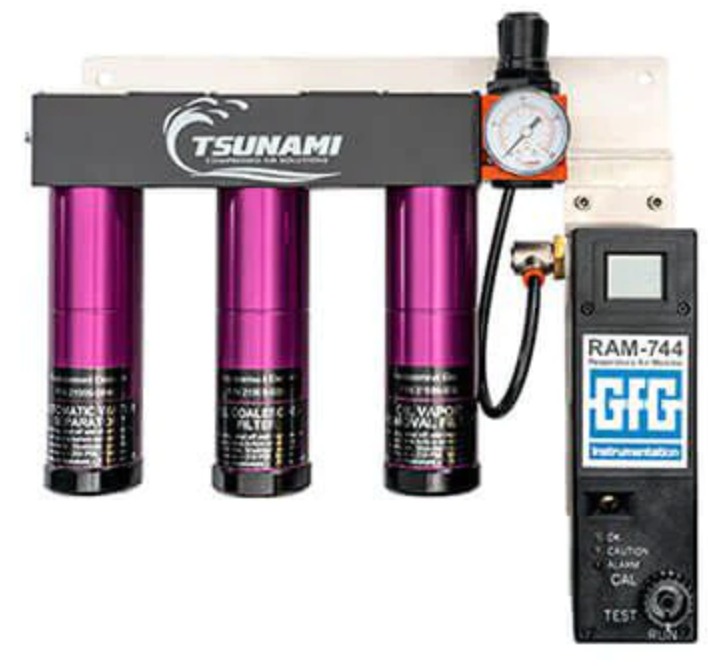Por qué es importante el aire respirable de calidad D
La seguridad es fundamental en cualquier lugar de trabajo. Como dice el refrán sobre seguridad en el lugar de trabajo: “Un empleado sin formación es un peligro para sí mismo y para los demás”.
Lo mismo ocurre con las herramientas, los equipos y los procesos que no cumplen los requisitos de seguridad. Estos pueden causar lesiones en el lugar de trabajo rápidamente y el aire que respiramos también es fundamental.
El aire respirable de grado D es esencial en todas las aplicaciones. El aire comprimido de grado D debe cumplir con estándares estrictos de múltiples agencias regulatorias, como la Administración de Seguridad y Salud Ocupacional (OSHA).
Cumplir con los requisitos de aire respirable de Grado D no es una tarea que se realiza una sola vez. Se requiere en instalaciones industriales y aplicaciones donde se utilizan máscaras respiratorias, boquillas y otros aparatos para la inhalación directa de aire. Los expertos deben hacer que el cumplimiento de las normas de cumplimiento forme parte de la rutina diaria, desde la inspección y reparación de los equipos hasta la formación continua de los empleados.
¿Qué es el aire respirable de grado D?
El aire respirable de grado D es aire comprimido que se transmite a través de un respirador y está destinado a ser utilizado como aire respirable por contratistas que manipulen materiales nocivos. Para que se considere aire respirable de grado D, se deben cumplir las siguientes condiciones:
- El aire debe estar libre de cualquier olor notable.
- Los hidrocarburos condensados no pueden superar los 5 mg/m
- El monóxido de carbono no puede superar las 20 partes por millón (ppm)
- El dióxido de carbono debe ser inferior a 1.000 ppm.
- El oxígeno debe ser del 19,5 al 23,5 % (por volumen)
 El aire respirable de grado D suele suministrarse desde un sistema de compresor ubicado dentro del área de aplicación o a través de un respirador. Esto permite un flujo de aire constante durante todo el proceso de aplicación. Se debe instalar y mantener un compresor de tornillo rotativo, un suministro de aire comprimido portátil o una bomba de aire libre de acuerdo con las normas CGA G-7. Los filtros deben cambiarse periódicamente para garantizar la máxima eficiencia y seguridad.
El aire respirable de grado D suele suministrarse desde un sistema de compresor ubicado dentro del área de aplicación o a través de un respirador. Esto permite un flujo de aire constante durante todo el proceso de aplicación. Se debe instalar y mantener un compresor de tornillo rotativo, un suministro de aire comprimido portátil o una bomba de aire libre de acuerdo con las normas CGA G-7. Los filtros deben cambiarse periódicamente para garantizar la máxima eficiencia y seguridad.
Es importante recordar que los requisitos de aire respirable de Grado D son una parte esencial para completar de manera segura ciertas tareas, como la aplicación de espuma en aerosol, y no deben tomarse a la ligera.
Requisitos de calificación de OSHA para aire respirable de grado D
La OSHA regula los estándares para el aire respirable de grado D. Según la OSHA, el aire comprimido utilizado para la protección respiratoria debe cumplir con ciertas especificaciones, como:
- Contenido de neblina de aceite no superior a 0,5 miligramos por metro cúbico
- Contenido de vapor de agua no superior a 5 miligramos por metro cúbico.
- Contenido de oxígeno no superior al 0,1 por ciento en volumen.
Siempre se debe utilizar protección respiratoria homologada al aplicar pinturas y revestimientos. Se recomienda encarecidamente el uso de respiradores de cara completa con filtros especiales y bien ajustados.
OSHA obliga a los empleadores a proporcionar a sus trabajadores protección respiratoria siempre que trabajen con aire comprimido que contenga contaminantes peligrosos, como vapores orgánicos o nieblas de aceite. Además, los empleadores deben garantizar que
Los trabajadores reciben capacitación sobre el uso y mantenimiento correcto de la protección respiratoria para garantizar la seguridad de todo el personal. Cumplir con los requisitos de aire respirable de Grado D de OSHA significa un ambiente de trabajo más saludable y un personal preparado e informado.
¿Qué son las normas CGA G-7?
La Asociación de Gas Comprimido ( CGA ) ha estado trabajando para desarrollar y promover estándares de seguridad durante más de 100 años. La CGA aboga por una “fabricación, transporte, almacenamiento, transbordo y eliminación cada vez mejores, seguros y ambientalmente responsables de gases industriales, médicos y alimentarios y sus contenedores”.
La industria se basa en las normas CGA G-7 para establecer las pautas para el aire respirable de grado D, específicamente en torno a la seguridad de los expertos en instalación de espuma en aerosol. Estas normas también son importantes para cumplir con las regulaciones que rigen la seguridad en las áreas de trabajo.
Las normas de la CGA son similares a las establecidas por OSHA, en el sentido de que el aire respirable de Grado D no debe contener:
- Más de 0,5 miligramos de partículas de aceite.
- Más de 5 miligramos de vapor de agua por metro cúbico
Las normas de monitoreo de monóxido de carbono para el aire respirable de Grado D requieren que los niveles permanezcan por debajo del límite aceptable de 25 ppm.
El protocolo también exige que los filtros de aire del compresor se inspeccionen y cambien periódicamente no solo para garantizar la eficiencia, sino también la seguridad del operador. Con cambios de filtro regulares, quienes aplican espuma en aerosol no están expuestos al polvo, la suciedad, las partículas de aceite u otros contaminantes dañinos.
Cumplimiento normativo | Aplicaciones monousuario vs. aplicaciones multiusuario
Cuando se trata de aplicaciones de espuma en aerosol, tanto las aplicaciones para un solo usuario como las para múltiples usuarios requieren aire respirable de grado D.
Si bien existen estándares CGA G-7 para ambas aplicaciones, existe una diferencia clave: un compresor utilizado por muchos usuarios al mismo tiempo debe estar equipado con un monitor de oxígeno para garantizar que cada usuario reciba aire respirable de Grado D.
Cómo comprobar si el aire respirable es de grado D
Es necesario probar el aire respirable de grado D para garantizar que cumple con los estándares de protección respiratoria requeridos.
Hay una serie de pruebas disponibles para verificar la presencia de partículas de aceite, vapor de agua, oxígeno y otros contaminantes peligrosos del aire.
Una de las pruebas más comunes que se utilizan para verificar el aire respirable de grado D es la prueba de neblina de aceite. La neblina de aceite puede generarse por lubricantes de compresores y otras máquinas y puede causar irritación respiratoria, tos y otros problemas de salud. La prueba de neblina de aceite mide la cantidad de partículas de aceite en el aire y se usa comúnmente junto con otras pruebas, como la prueba de rocío.
La cromatografía de gases es una técnica analítica que se utiliza para detectar la presencia de contaminantes en el aire. La cromatografía de gases analiza la pureza del aire en cuestión (para nuestros fines, el aire comprimido que se respirará durante el funcionamiento). Esta prueba es una técnica muy sensible y precisa, lo que la hace adecuada para analizar la pureza del aire respirable.
Debido a que los requisitos de pruebas de aire respirable de Grado D tienen requisitos específicos que cumplir, las pruebas deben ser realizadas por un profesional experimentado.
¿Por qué existen requisitos de aire respirable de grado D?
Es necesario cumplir con los requisitos de aire respirable de grado D para minimizar las lesiones o muertes en el lugar de trabajo. Optimizar el aire respirable que los expertos en instalación tienen a su disposición significa confiabilidad y mejor moral en el lugar de trabajo, así como trabajadores saludables. Cuando se cumplen los requisitos de OSHA y reglamentarios, los expertos en instalación de espuma en aerosol pueden tener la tranquilidad que prefieren al comenzar un trabajo.
Dónde comprar equipos de aire respirable de grado D
TFS suministra varias marcas de equipos de aire respirable, incluida Tsunami , a quien agradecemos por este blog. Visite TotalFinishingSUPPLIES.com para obtener más información.
Sistema de aire respirable en caso de tsunami, parte 21999-0265
Sistema de aire respirable en caso de tsunami, parte 21999-0980


EPI Martech


